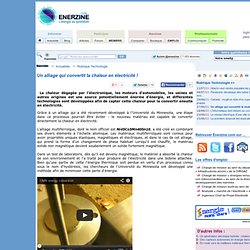

Australian scientists are taking their printable solar cells to the market. Australian scientists are close to putting their cheap, printable solar cells on the market, to be used on everything from iPad covers, laptop bags and smartphone skins, to rooftops and windows.

Scientists Create Transparent Solar Concentrator. Des plastiques à base d'algues 100 % biodégradables - FUTUREMAG - ARTE. Solar Roadways. Artist's rendition of Sandpoint, Idaho - Home of Solar Roadways Graphic artist: Sam Cornett Artist's rendition of a sidewalk/parking lot application.

Thanks to Sam Cornett and Craig Fine Solar Roadways is a modular paving system of solar panels that can withstand the heaviest of trucks (250,000 pounds). These Solar Road Panels can be installed on roads, parking lots, driveways, sidewalks, bike paths, playgrounds... literally any surface under the sun. Solar Roadways - Introduction.
We are excited to announce that Indiegogo has asked us to join their InDemand program: It allows teams to continue raising funds for their projects.

We are very excited about this for many reasons: We've had numerous requests since our original campaign ended: "Can I still donate? ", "Can I still get a Solar Roadways perk? " Un alliage qui convertit la chaleur en électricité ! > Technologie. La chaleur dégagée par l'électronique, les moteurs d'automobiles, les usines et autres origines est une source potentiellement énorme d'énergie, et différentes technologies sont développées afin de capter cette chaleur pour la convertir ensuite en électricité.

Grâce à un alliage qui a été récemment développé à l'Université du Minnesota, une étape dans ce processus pourrait être éviter - le nouveau matériau est capable de convertir directement la chaleur en électricité. L'alliage multiferroïque, dont le nom officiel est Ni45Co5Mn40Sn10, a été créé en combinant ses divers éléments à l'échelle atomique. Les matériaux multiferroïques sont connus pour avoir propriétés uniques élastiques, magnétiques et électriques, et dans le cas de cet alliage, qui prend la forme d'un changement de phase habituel Lorsqu'il est chauffé, le matériau solide non magnétique devient soudainement un solide fortement magnétique.
Sur une décharge des Philippines, le méthane transformé en électricité - 4 avril 2013. MANILLE (AFP) - Dans un bidonville de Manille, Teresita Mabignay repasse son linge avec l'électricité gratuite produite grâce à une montagne d'ordures.

La décharge de Payatas a été la première aux Philippines à être dotée d'un mécanisme permettant de convertir son méthane en électricité, dans le cadre d'un programme des Nations unies destiné à lutter contre le changement climatique. Les ordures en décomposition dégagent du méthane, un gaz à effet de serre accusé de contribuer au réchauffement, selon les scientifiques. Le transformer en électricité évite qu'il se propage dans l'atmosphère, mais permet aussi de réduire la consommation d'énergies fossiles. Des tuyaux enfouis sous la montagne de déchets récupèrent le gaz et le conduisent jusqu'à une centrale électrique à proximité.
Teresita Mabignay, 50 ans, et ses voisines du bidonville, situé au pied de la décharge, ont accès à une électricité gratuite, dispensée dans un hall de la centrale. The Impending Revolution of 3D Printed Graphene. Posted on October 22, 2013 3D Printing Graphene - A Total Game Changer When we first heard about graphene, we knew that it was going to be the next big thing.

For those not in the know, graphene is basically a sheet of nano-structured carbon atoms. Touted as the strongest material known to man, it is currently manufactured in transparent, flexible sheets that are only 1 atom thick. Aside from it's strength, light weight and flexibility, what really makes this material unique is how well it conducts heat and electricity, making it an ideal choice for printing circuit boards and the thinnest computer/tv displays you can imagine. The U.S. Navy Just Announced The End Of Big Oil And No One Noticed -
Surf’s up!

The Navy appears to have achieved the Holy Grail of energy independence – turning seawater into fuel: After decades of experiments, U.S. L'ère du pétrole à volonté. Il ne s’agit pas d’un canular digne du 1er avril ou d’un délire issu d’un livre de science-fiction.

C’est une information vérifiée et confirmée. Après des décennies d’expériences, des scientifiques de la marine américaine ont été capables de transformer de l’eau de mer en hydrocarbures. L’US Navy vient ainsi d’annoncer l’ère du pétrole sans limite, le Graal de l’abondance et de l’indépendance énergétique, et personne ou presque ne s’en est aperçu. L’idée semble pourtant presque simple. Les carburants fossiles sont constitués d’hydrocarbones (hydrogène et carbone). Publicité Le prix de revient de ce nouveau carburant est aujourd’hui estimé entre 3 et 6 dollars par gallon (3,7 litres). Car le processus consiste à retirer du dioxyde de carbone des océans. Les conséquences économiques et géopolitiques du développement à une grande échelle de cette technologie seraient considérables et difficiles à imaginer.
Graphene: The Next Tech Revolution? Le méthane, une solution de stockage pour la transition énergétique ? Afin de réduire les problèmes d'intermittence des ENR, le projet VGV propose de stocker sous forme de méthane les excédents électriques pour réinjecter l'énergie lors des pointes.

Une solution étudiée en Allemagne en synergie avec la méthanisation. L'intermittence reste l'un des principaux talons d'Achille des énergies renouvelables. Mais pour le professeur Robert Bell du Brooklyn College de New-York et l'eurodéputée Corinne Lepage, l'argument ne tient pas si l'on met en place un système de stockage de l'énergie excédentaire performant et souple. Leur solution ? Le système volt gaz volt (VGV) qui vise à stocker l'énergie excédentaire sur le réseau gazier en convertissant l'électricité en méthane (CH4). Cette prise de position de l'ancienne ministre de l'Ecologie intervient alors que la France débat de sa transition énergétique.
Tirer profit du CO2 issu de la méthanisation Les bénéfices seraient multiples, selon les promoteurs.